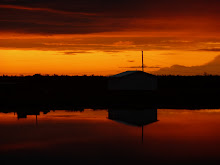Simplistically, without the first two, earth and the atmosphere, we can’t have the third, cultures.
Watching the clip on the Bush Pilots reminded me of talking to an elder who was visiting the school my first year. It was bitter cold and had been for days. We were standing near a window. He pointed up and told me “Look at the ring around the sun. When you see that, do not go out. It means terribly cold weather.” He went on to tell me of a time when he was young and the same thing had happened. He told of the concern he had for his sled teams because it was so cold it would hurt the dogs’ feet and they would bleed. Like the man said it is just “ice crystals” high in the ionosphere but what a valuable warning.
Changes in the weather patterns can be the downfall of a civilization. For example Cahokia Mounds, in Illinois, was a thriving metropolis with more citizens than same- era-London. The most popular theory of their downfall was a slight climate change that made it harder for enough crops to grow to support all of those people. For hundreds of years the climate had supported a growing river culture that traded widely throughout the continent. A few degrees difference in the temperature and the culture could no longer sustain itself, dispersing into history, leaving behind little but their mounds. Even their name is gone (Cahokia is actually a name of a later people that lived there). Atmospheric changes caused temperature changes that changed how plants were able to grow which in turn destroyed the culture.
Looking at the weather patterns and the Jet Stream clips, it reminds me of a swirling jigsaw puzzle. Each piece fitting in next to another. When the pieces move in various patterns then different results happen. Growing up in the Midwest, I have personal knowledge of the effect of Jet Streams on the way people live. I remember vividly the flood in ’93 (and other floods, too). The change in the Jet Stream brought devastating moisture to the area. Many people lost homes, crops, and possessions. I remember co-workers who had to drive several hours to work when it normally took 20 minutes. Kids down the road from my family had to walk along levees and then take a boat across the flooded river bottom to get to their high school. The flooding of ’93 and ’95 may not have changed the American culture as a whole but it made small changes in the way people lived around the rivers. Many people moved after the flood. I know of those who changed professions. River management changed as well. Levees were moved and even a whole town moved several miles.
This has been another year when the Jet Stream, good ol’ El Nino, has been bringing in extra moisture to the lower 48. Even though it is in the lower 48 it still affects us here. Think of the swirling jigsaw puzzle, each piece pulling and tugging at another. We have had very little snow this year with warmer weather than normal. Talking to people here, the same thing has happened before.
With our frequently changing weather this year we have had what some of the local people call "Tundra Mirage". At night we see the lights of the surrounding villages, where normally we can not. During the day we are able to see what I am told is Nelson Island. This happens in the winter when it is going to get a lot colder and in the spring when it is going to get a lot warmer. It is a beautiful sight.
New Orleans is not the only place they say “its not the heat, it’s the humidity”. It is a common saying from my childhood too. I mention this because I find its true of the cold too. When I visit my family at Christmas, I find that I get colder much easier. It is usually at least 30 degrees warmer so why am I so cold? I believe it is because we have such dry cold here. It does not seep into the skin and bones as easily (at least not if the wind is blowing in a wind chill of -30plus). I know that the process of freezing water is suppose to give off heat, but it is not enough to keep me from freezing myself!
“* What are the practical values of Teachers' Domain and National Geographic digital resources for your professional purposes?”
Teaching in a tundra village, where my students have limited experience and interaction outside of their immediate areas, these resources are great to visually show them parts of the world they may not other wise see. The students love watching clips from NG.
“Helpful Hint: These four questions came right from the Teachers' Domain interactive resources linked to, Vertical Structure of the Atmosphere. Can you find them?”
These questions are the four questions that came with the clip. Just click on the tab marked discussion questions
Subscribe to:
Post Comments (Atom)


No comments:
Post a Comment